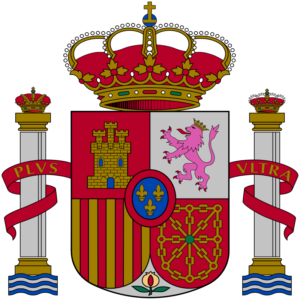order of chivalry
kingdom of spain
history of spain
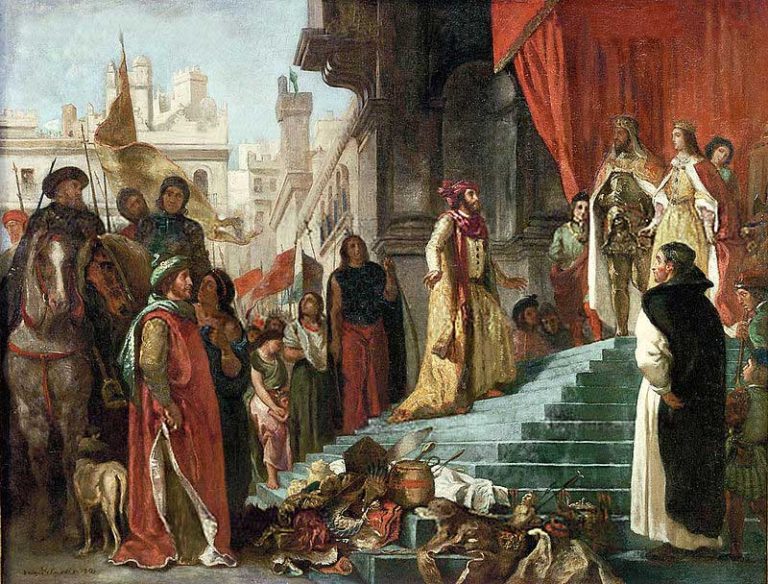
Columbus visiting the court of ferdinand and isabel
Most of the Iberian Peninsula has been populated since prehistoric times. Early evidence of human habitation unearthed at the Atapuerca site in northern Spain are some 800,000 years old. Modern man made his appearance around 35,000 BC. Sometime around 4000 BC, much of Spain was settled by the Iberians, arriving from the east. The Celts arrived later, settling in the northern third of the peninsula. Bronze age civilization flourished in the south, culminating with the Tartessian civilization around Seville (1000-500 BC).
Around 1100 BC, Phoenician seafarers from present-day Lebanon set up trading colonies in Cadiz and elsewhere along the Spanish coast. Greeks also traded along the north-eastern coast. With the fall of Phoenicia, the Iberian Peninsula came under the rule of Carthage (present day Tunisia), but was occupied by Rome following the Punic Wars. The Romans held sway in Iberia for six centuries, laying the foundations for Spanish language and culture.
Following the fall of the western Roman empire in the fifth century AD, Spain was ruled by the Visigoths, a Germanic people who had migrated from central Europe. In 711, the Muslims of northern Africa launched an invasion across the Strait of Gibraltar, occupying most of the peninsula within a few years. Their presence lasted more than seven centuries.
The Christian kingdoms to the north increased in power over the generations. Spain was ultimately unified through the marriage of Isabel I of Castile and Fernando II of Aragon, and Granada, the last Moorish stronghold, was reclaimed by the “Catholic Monarchs”. The holy war continued by way of the Spanish Inquisition wherein large numbers of non-Christians were persecuted and often sentenced to death. Despite this turmoil, Spain flourished in art and architecture during this period. Further, Spain embarked on an age of discovery as the voyages of Columbus and the conquistadors opened new vistas in the New World. This Golden Age, which lasted through the 16th century, was also one of the great artistic and literary periods, producing the lasting achievements of such notable painters as El Greco and Valzquez; such writers as Cervantes; and such dramatists as Lope de Vega and Calderon de la Barca.
The discovery of the New World by Christopher Columbus was to mark Spanish history forever. Treasure from Spain’s vast overseas empire pushed Spain into the forefront of European countries, but constant warfare drained resources. During the 16th century, the Spaniards fought the Turks and the French. From 1568 The Netherlands, which was ruled by Spain, rebelled, and began a long war of independence. Furthermore from 1587 to 1604, Spain fought a war with the English.
In 1700 King Carlos II died and in his will, he left the kingdom of Spain to a Frenchman named Philip of Anjou. However other European powers would not accept this as it would mean a powerful alliance between France and Spain.
In 1701 the War of the Spanish Succession began between Austria and France. Britain and the Netherlands joined Austria against France in 1702. The British captured Gibraltar in 1704 and Minorca in 1709. The Treaty of Utrecht, 1713, ceded both by Spain to Britain. By the Treaty of Rastatt and Baden in 1714, Austria took Belgium from Spain.
Despite the war, King Philip of Felipe strengthened the Spanish monarchy. The various regions of Spain were integrated into a single state. During the 18th-century Spanish agriculture expanded and became more productive. The population of Spain increased during the century. So did trade and commerce.
In 1808 Napoleon forced the Spanish king to abdicate and he made his brother Joseph king of Spain. However, the Spanish people refused to accept him. As a result, Napoleon led an army into Spain and captured Madrid. The Spaniards fought a guerrilla war against the French. This time the British were their allies. The French were driven out of Spain in 1813.
Ferdinand became king in December 1813, but in 1814 he declared he intended to rule as an absolute monarch. This was contradicted the 1812 constitution making Spain a constitutional Monarchy. In 1820 General Rafael de Riego forced Ferdinand to accept the constitution. Yet in 1823 the French king sent an army to restore Ferdinand to absolute power.
Meanwhile, Spain’s colonies in Central and South America rebelled, and between 1818 and 1824 they gained their independence. In 1819 Spain was forced to cede Florida to the United States.
Ferdinand died in 1833 and Spain was plunged into a civil war between During the 19th century, Spain was sharply divided between conservatives and liberals, and rural and urban society. Coups d’etat and changes of government were frequent. With the increasing power of the working class, in 1931 king Alfonso XIII was forced to abdicate, and Spain was declared a republic.
In 1936, the Spanish Civil War erupted, with Nationalists under General Franco fighting the seated Republicans. With the help of Hitler and Moussolini, the Nationalists eventually claimed victory and executed thousands of Republicans. After Franco’s death in 1975, the country shifted from a dictatorship to a democracy. The current king, Juan Carlos I, is a constitutional monarch and is lauded for his support of democracy. As a fruit of its new freedoms, the country celebrated a cultural renaissance in the 1980s and 1990s, and in 1992 hosted both the Summer Olympics in Barcelona and the Expo ’92 in Sevilla.
The Spanish economy continued to grow strongly during the late 20th century, although unemployment was high. In 1986 Spain joined the European Union, and in 1999 Spain adopted the Euro as its currency. Spain suffered badly in the recession from 2008 and unemployment rose to a very high level. Unemployment in Spain reached a peak in 2013. However, it then fell. From 2014 onward Spain recovered from the crisis. Today the economy of Spain is growing steadily. In 2020 the population of Spain was 47 million.
culture of spain
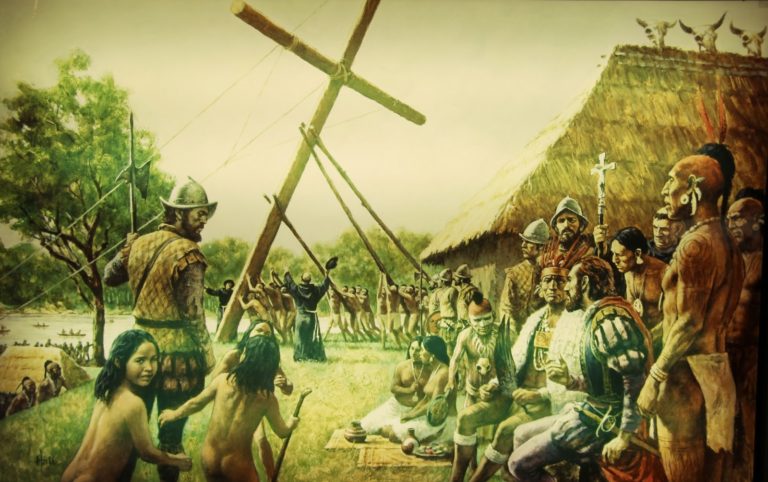
Spanish conquistadors bringing catholocism to the new world
Spain has a diverse culture, shaped by thousands of years of occupation by different empires. The ancient Greeks, Romans, Moors, Celts, Carthaginians and Phoenicians who settled in the country all left their mark on the cultural heritage of the country. Religion (and Christianity in particular) is also an important factor in shaping the traditions and customs in Spain.
Social beliefs and customs practiced in Spain are influenced by the local religion and traditions. Spaniards are known for being courteous and will shake hands when they meet and when departing. When interacting with the elderly they show respect by using titles such as don for men and doña for women. Married women wear wedding rings on their right hands as opposed to the left hand.
Spain is a country with a deep religious tradition, and is responsible for the spread of Christianity to many parts of the world. For centuries now, Roman Catholicism has been the primary religious faith of the Spanish people, even though it no longer holds any official status under the law in the new democratic Spain. Still, in all Spanish public schools, students are required to take either a religion or ethics class as part of the regular curriculum, with Roman Catholicism being the only choice for the former. Other religious faiths are also adhered to in present day Spain, although none of them account for a very sizable minority.
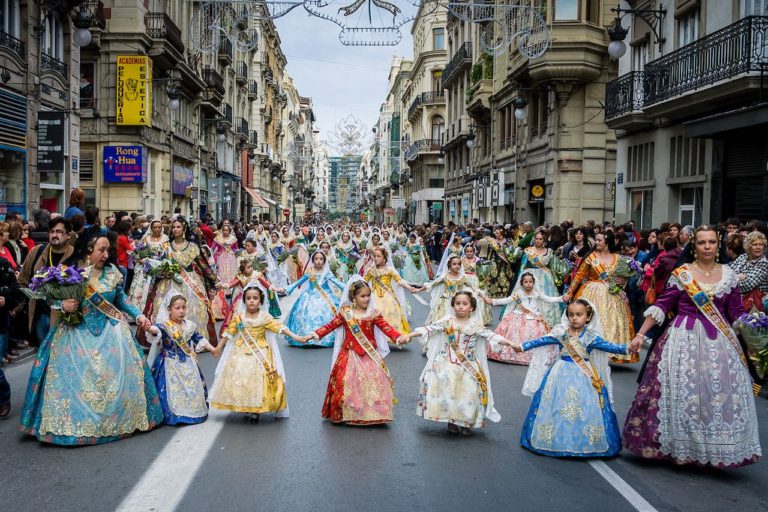
girls dressed up for the las fallas celebration
Spain is home to many unique festivals and celebrations throughout the year. Las Fallas is one of Spain’s most impressive festivals. The event takes place each March in the Mediterranean city of Valencia.The celebration lasts for a week and includes nonstop fireworks and noisy fanfare.
The southern city of Seville plays host to two of the largest celebrations of the year. The first of these is Semana Santa, a week of feasting and Roman Catholic processions leading up to Easter. The festivities include masked parades and enormous floats with Roman Catholic figures. This somber spectacle is followed up by La Feria de Abril, a much more joyous event, featuring hundreds of tents and amusement park rides, and locals dressed in traditional garb.
La Fiesta de San Fermin is a celebratory and quite iconic holiday that takes place in the northern Spanish town of Pamplona. The festivities occur annually in mid-July. The most well-known feature of this celebration is the oft-publicized “Running of the Bulls,” an event first made famous by American author Ernest Hemingway in his novel The Sun Also Rises.
Finally, there is La Tomatina, an all-out “tomato war” hosted by the town of Buñol, Spain, just outside Valencia. Tourists and locals alike gather here on the last Wednesday of August each year to stage a tomato-chucking battle of epic proportions. This event is part of a week-long festival in honor of Buñol’s patron saint.
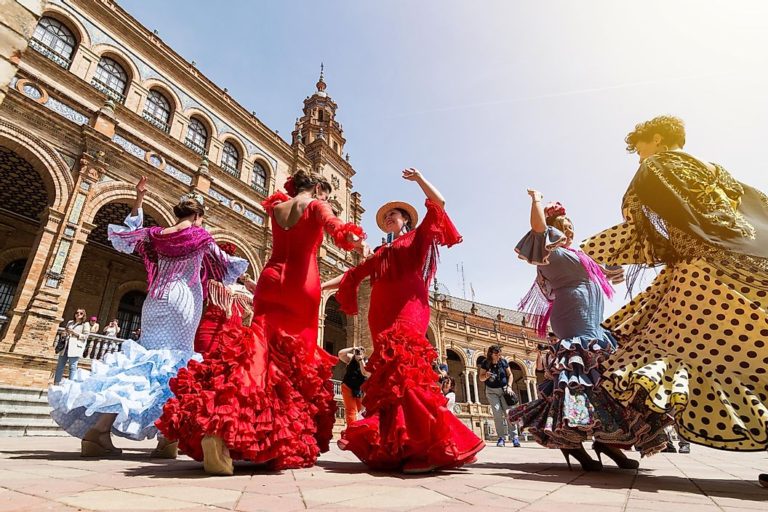
flamenco dancing in spain
Spain has a vibrant music and dance scene with a wide array of genres ranging from traditional, classical music to modern genres. The music and dance are widely influenced by the cultural diversity of the country with different regions having distinct music styles. The region of Andalusia is known for the flamenco music and dance which incorporates the traditional seguidilla style. Other popular genres from the region include Sephardic and copla genres. Some notable musicians from Andalusia include Carlos Cano, Javier Ruibal, Joaquin Sabina and Luis Delgado.
The Aragon region is known as the birthplace of Jota music which is popular all over the country and features the use of tambourines, guitarro (a small traditional guitar), castanets, and the bandurria. The stick-dance, as well as the dulzaina dance, originated from Aragon. In the Canary Islands, a variation of Jota music known as Isa is common and is widely influenced by Cuban music.
Catalonia is known as the home of the Rumba Catalana, a type of rumba music created by the Catalan Romani with Rock Catalana being the popular music genre among young people from the region. In Valencia, Jota music is popular among residents who are also popular for performing bandes, local brass bands.
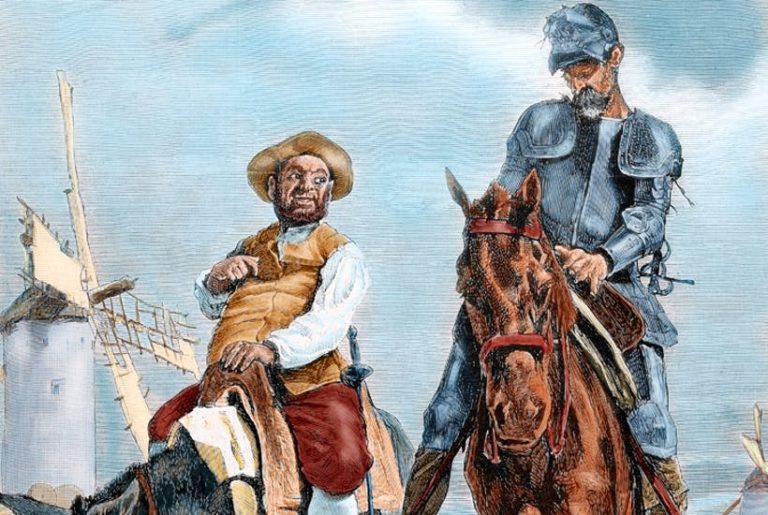
a portrayal of "don quioxte"
Literature in Spain has a rich history going back hundreds of years. One of the most popular literary works in Spain is La Celestina, a 1499 book written by Fernando de Rojas which is considered by many people as the best example of Spanish literature in history. A popular literary genre of Spanish literature is the picaresque novel whose origin is traced back to a 16th-century novel entitled Lazarillo de Tormes. The picaresque genre is where readers can follow the adventures of a rogue protagonist, and the most significant example of a Spanishpicaresque novel still commonly read today is Don Quixote.
Spain also has a reputable art scene with accomplished artists such as Salvador Dalí, Antoni Tapies, Juan Gris, and Joan Miro being known around the world. However, the most famous Spanish artist is Pablo Picasso, whose catalogue of works includes sculptures, paintings, ceramics, and drawings. The best locations to sample Spanish art at its finest are through its museums which include the Prado Museum, the Reina Sofia National Museum, and the Thyssen-Bornemisza Museum.
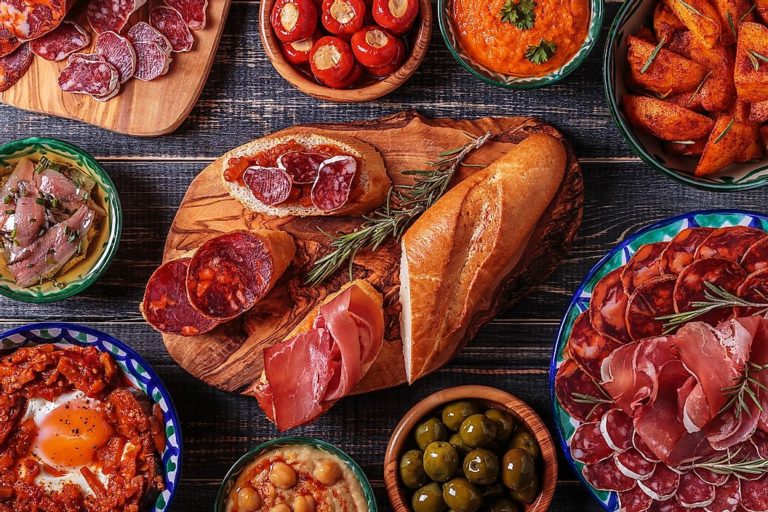
traditional tapas
Roman, Jewish and the Arab tradition has had a significant impact on the Spanish cuisine. The strong influence of Moorish people in Spain also reflects on the Spanish cuisine.
Olive oil is very widely used across Spain, 44% of world’s olives are produced by Spain. Lard and butter are also used in Spain.
Cuisine plays a major role in Spanish culture, with dishes that vary depending on geographic location and climate. The cuisine is heavily influenced by the seafood available from the waters that surround the country, reflecting the country’s deep Mediterranean roots. The long and storied history of Spain has brought many cultural influences into the fold, leading to a cuisine that is not only delicious but also rather unique. Generally, the cuisine of Spain can be divided between three major geographical divisions:
Cuisine of the Mediterranean Region. The coastal Mediterranean regions of Spain, ranging from Catalonia to Andalusia, make heavy use of the available seafood in the area, with dishes such as pescaíto frito. Rice dishes, such as paella from Valencia and the Catalonian arròs negre are also very popular, as are cold soups like gazpacho, due to the region’s warm weather.
Inland or Center Spanish Cuisine. In the inner regions of Spain, such as Castile, hot, thick soups, such as the bread and garlic-based Castilian soup are extremely prevalent. So too are hearty substantial stews, such as cocido madrileño. Food in this region is traditionally conserved by salting, as in Spanish ham; or immersed in olive oil, like Manchego cheese.
Cuisine of the Atlantic Region. The Northern Spanish coast, including the Asturian, Basque, Cantabarian and Galician regions, feature a unique cuisine, one characterized by vegetable and fish-based stews, such as Pote gallego and marmitako. People here also enjoy the lightly-cured lacón ham. The Northern region is best known for a cuisine relying heavily on ocean seafood, with dishes made from Basque-style cod, albacore and anchovy, or the Galician octopus-based based polbo á feira and shellfish dishes.
Serving tapas with a drink is a very popular custom in Spain. Sherry, wine and beer are the usual drinks served with the tapas. There are some cities in Spain where tapas are served free with a drink and this has become really popular in the country. There are many bars in Spain that serve something edible for free when a drink is ordered while there are some others that primarily exist to serve a purchased tapa.
Sofrito is also very frequently used by Spaniards to start the preparation of several dishes. Onions and garlic is used as major seasonings. The Spaniards like drinking wine with their meals and this has almost become a custom. Bread is also very frequently consumed by the Spaniards, during the summer salad becomes indispensable. Tarts and cakes are eaten as desserts on special occasions in Spain
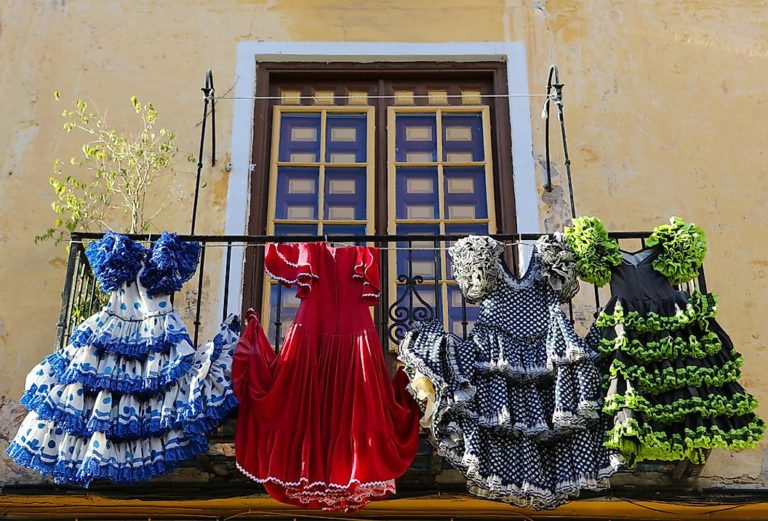
traditional spanish dresses
The clothes worn in Spain feature both traditional as well as modern influences. Young Spaniards, particularly from urban centers, sport western-styled clothing such as jeans and sundresses. However, there are various articles of clothing from traditional Spanish culture that can still be seen and include the Zamarra, a long coat made of sheepskin; the Barretina, a traditional male hat popular in Catalonia; the Traje de Flamenca, a long dress worn by Andalusian women; and the Sombrero cordobés, a wide-brimmed hat commonly worn in Andalusia.
HIs Majesty, the king of spain
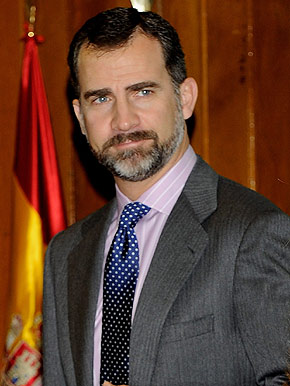
His Majesty, King Philip VI of Spain
Felipe VI or Philip VI Felipe Juan Pablo Alfonso de Todos los Santos de Borbón y Grecia; born 30 January 1968 is the King of Spain. He ascended the throne on 19 June 2014 upon the abdication of his father, Juan Carlos I. His mother is Queen Sofía, and he has two elder sisters, Infanta Elena, Duchess of Lugo, and Infanta Cristina. In 2004, Felipe married TV news journalist Letizia Ortiz with whom he has two daughters, Leonor, Princess of Asturias, and Sofía, Infanta of Spain.
In accordance with the Spanish Constitution, as monarch, he is head of state and commander-in-chief of the Spanish Armed Forces with military rank of Captain General, and also plays the role of the supreme representation of Spain in international relations.
The King holds the military rank of Captain General of the Army, the Navy and the Air Force, the highest military rank, which corresponds exclusively to the supreme commander of the Armed Forces.
He is a great-great-great-grandson of Queen Victoria of the United Kingdom and 3rd cousin once removed of Elizabeth II of the United Kingdom.
In 1981, he received the Collar of the Distinguished Order of the Golden Fleece, granted by His Majesty the King Juan Carlos, Head and Sovereign of the Order.
charitable causes
In addition to his official activities, King Felipe is Honorary President of diverse Associations and Foundations, to whose activities he is especially committed, participating in working meetings and chairing the meetings of their Boards of Trustees. Noteworthy among these are the Prince of Asturias Foundation, the Prince of Girona Foundation, and the Hesperia Foundation.
The Prince of Asturias Foundation was constituted in Oviedo (Asturias) on 24 September 1980, and seeks, among other goals, to enhance and promote the cultural and moral values that contribute to the progress of humankind. As a symbol, the internationally-renowned “Prince of Asturias” Awards are granted each year, at a ceremony presided over by His Majesty each October in Oviedo.
La Prince of Girona Foundation was born in 2009 with the purpose of supporting young people, promoting their entrepreneurial spirit in the business, social, scientific, academic and cultural spheres. Its central event is the Impulsa Forum, which is held each year in Girona.
Together with the Queen, he presides the Hesperia Foundation, created in 2010 to promote projects of a social nature involving youth, especially young people in the most underprivileged situations.
He also holds regular working meetings with the Codespa Foundation, dedicated to combating poverty through economic and social development, and with the Elcano Royal Institute, the principal Spanish think tank generating thought and ideas in the field of international and strategic relations.
More information on thr Royal family as well as their supportedc causes can be found at: Inicio – His Majesty King Felipe VI – Activities (casareal.es)
president of the government
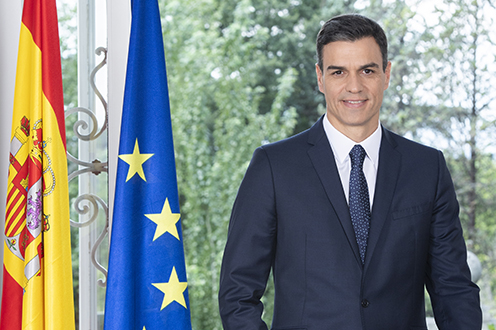
the most excellent Dr. Pedro Sanchez, President of the Government of Spain
Dr. Pedro Sánchez, born on 29 February 1972, has been President of the Government of Spain since June 2018. He holds a Doctorate in Economics and is General Secretary of the Spanish Socialist Workers’ Party (PSOE), which he joined in 1993. He was also General Secretary of the PSOE, Leader of the opposition and candidate to the Presidency of the Government between 2014 and 2016. Previously, he was a Member of the Lower House of Parliament for the constituency of Madrid and a City Councilor for Madrid.
Dr. Sánchez completed his secondary school studies at the Ramiro de Maeztu Institute in Madrid where he was a member of the Estudiantes basketball squad. In 1995, he graduated in Economic Science and Business Studies from the María Cristina Royal University College, a center attached to the Complutense University of Madrid. He subsequently completed two postgraduate courses: a master’s degree in EU Economics from the Free University of Brussels and a diploma in Advanced European Economic and Monetary Integration Studies from the Ortega y Gasset University Institute.
In 2012, Pedro Sánchez received his Doctorate in Economics from Camilo José Cela University, where he lectured in economics.
Prior to becoming a university lecturer, he worked as an adviser at the European Parliament and was a member of the cabinet office of the United Nations High Representative for Bosnia Herzegovina.
Dr. Sánchez is married to María Begoña Gómez Fernández and they have two daughters, Ainhoa and Carlota.
Chivalric orders
Chivalric orders of Spain are historic and unique. In addition to the Orders of State. The King is patron of a dynastic order which was founded in 1430 as well as four historic orders that exist today as a federation of organizations which the king also patron of.
dynastic order: Order of the golden fleece
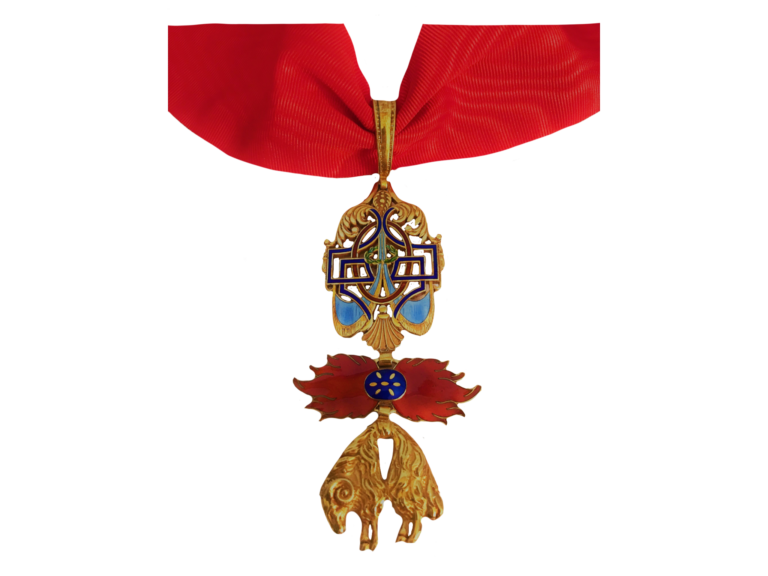
neck jewell of the order of the golden fleece
Order of the Golden Fleece, is a chivalrous Order founded in 1430 by the Duke of Burgundy, Philip III of Burgundy. It was established in Spain by Philip II, although his father Charles I attempted to found it before him.
The Distinguished Order of the Golden Fleece is a Catholic order of chivalry founded in Bruges by Philip the Good, Duke of Burgundy, in 1430, to celebrate his marriage to Isabella of Portugal. It is based upon the story of Jason and the Argonauts. Today, two branches of the order exist, namely the Spanish and the Austrian Fleece; the current grand masters are Felipe VI, King of Spain and Karl von Habsburg, head of the House of Habsburg-Lorraine, respectively.
The separation of the two existing branches took place as a result of the War of the Spanish Succession. The grand master of the order, Charles II of Spain (a Habsburg) had died childless in 1700, and so the succession to the throne of Spain and the Golden Fleece initiated a global conflict. On one hand, Charles VI, Holy Roman Emperor, claimed the throne as an agnatic member of the House of Habsburg, which had held the throne for almost two centuries. However, the late king had named Philip of Bourbon, his sister’s grandchild, as his successor in his will. After the defeat of the Habsburgs in 1714, Philip was recognized as king of Spain and the fate of the order was never clearly decided. The two dynasties, namely the kings of Spain and Habsburgs of Austria, have ever since continued granting the Golden Fleece in relative peace.
The Golden Fleece, and particularly the Spanish branch of the order, has been referred to as the most prestigious and historic order of chivalry in the world. Jean-François, baron de Bourgoing, French ambassador to Spain, wrote “the number of knights of the Golden Fleece is very limited in Spain, and this is the order, which of all those in Europe, has best preserved its ancient splendor”. Current knights of the order include Queen Elizabeth II, Emperor Akihito of Japan, former Tsar Simeon of Bulgaria, and Queen Beatrix of the Netherlands, amongst 13 others.
The current Grand Master of the Spanish Order of the Golden Fleece is His Majesty, King Philip VI.
orders of the kingdom of spain
The Royal and Distinguished Spanish Order of Carlos III
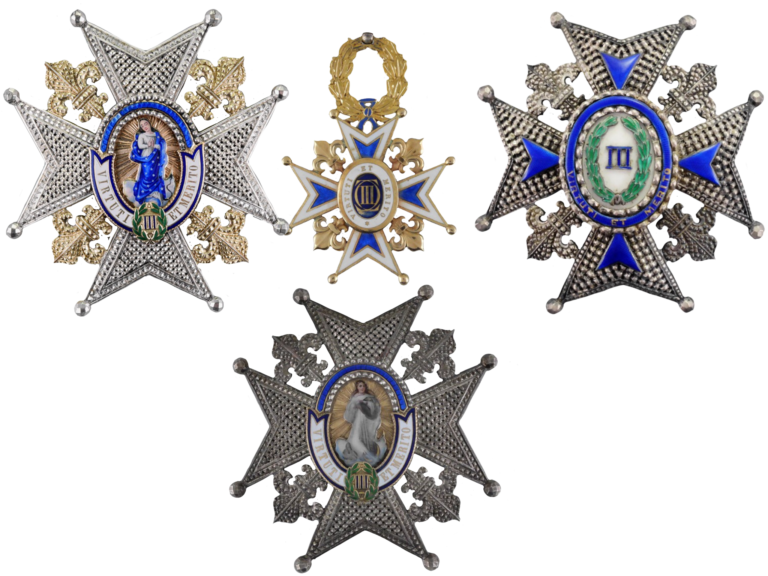
neck jewell and chest stars of the Order of Charles III
The Royal and Distinguished Spanish Order of Charles III was instituted by King Don Carlos III, by Royal Decree of September 19, 1771, to reward citizens who, through their efforts, initiatives and work, have rendered eminent and extraordinary services to the Nation. The motto of which its founder endowed it since its creation, “Virtuti et merito”, is the best description of the purpose of the Order. The Royal and Distinguished Spanish Order of Charles III is the highest honorary distinction among the Spanish Civil Orders and is among the oldest of those currently preserved in the world.
His Majesty the King is the Grand Master of the Royal and Distinguished Spanish Order of Charles III. All degrees of this Order shall be conferred on His behalf and the corresponding titles shall be authorized with His signature.
The President of the Government will be the Grand Chancellor of the Royal and Distinguished Spanish Order of Charles III.
The orders are currently conferred in the following grades:
Collar (Collar) – restricted to 25 Spanish citizens (not including members of Spain’s royal family).
Grand-Cross (Gran-Cruz) – restricted to 100 Spanish citizens (limit excludes government ministers).
Commander of Number (Encomienda de Número) – restricted to 200 Spanish citizens (limit excludes government ministers).
Commander, optional Dame’s Bow.
Cross .
There are no restrictions on the number of foreigners that may be appointed to any of the grades.
The Grand Cross of the Order of Charles III is reserved for those who, having completed relevant service to Spain, having been Presidents of the Congress of Deputies, the Senate, the Constitutional Court of the Supreme Judicial Council, the Supreme Court, Ministers, or other senior officials of the state. The maximum number of Grand Crosses are limited to one hundred, not counting those accorded to Ministers.
Knights Collar and Knights Grand Cross of the Order are entitled to be addressed with the style The Most Excellent in front of their name. Other members are entitled to the style of The Most Illustrious.
The Royal Order of Noble Ladies of Queen Maria Luisa
The Royal Order of Noble Ladies of Queen Maria Luisa is an Order created by King Charles IV of Spain by royal decree on April 21, 1792, at the request of his wife, Queen Maria Luisa, to reward noble women who distinguished themselves for their services and talents. As such, it was established as an honour reserved only for women.
Currently, and according to the statutes, there is a single category of Noble Lady, limited to 30 members except on the express will of the monarch. Since the resignation of Don Juan de Borbón, Count of Barcelona to his dynastic rights on May 14, 1977, during the reign of Juan Carlos I, there have been no new appointments so that, although it formally remains in effect, it can be considered that this order is de facto extinct.
The order of Isabel the catholic
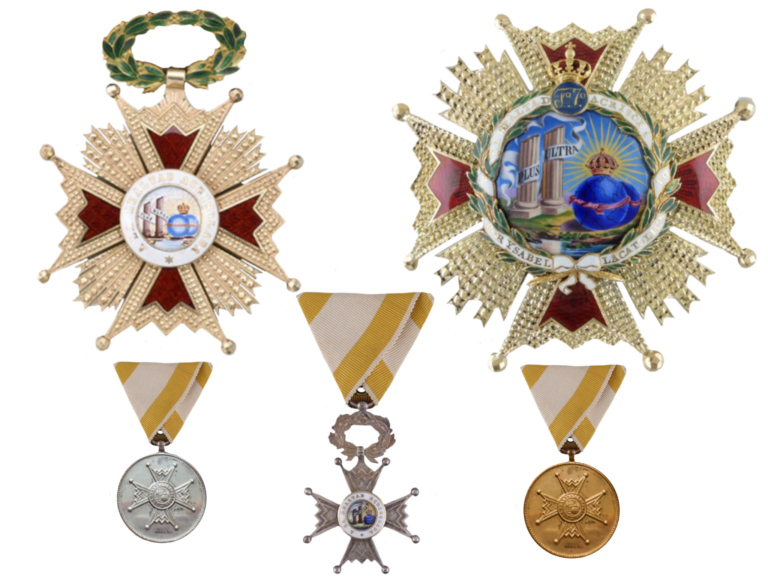
neck jewell and chest stars and medals of the order of isabel the catholic
The Order of Isabel la Católica , originally the Royal and American Order of Isabel la Católica, was created by King Fernando VII on March 14, 1815, with the objective of rewarding those extraordinary behaviors of a civil nature, carried out by Spanish and foreign people, that redound to the benefit of the Nation or that contribute, in a relevant way, to favor the relations of friendship and cooperation of the Nation Spanish with the rest of the international community. By Royal Decree of July 26, 1847, this Order was reorganized, taking the name of the Royal Order of Isabel la Católica.
The Order of Isabel la Católica will consist of the following degrees: Necklace, Grand Cross, Commendation of Number, Commendation, Officer Cross, Cross, Silver Cross, Silver Medal, Bronze Medal.
The Knights and Ladies of the Collar, as well as the Grand Cross Knights and Ladies, will receive the treatment of His Excellency and Her Excellency.
Those who receive the Order Number Entrustment will have the treatment of most illustrious sir or illustrious lady.
The order of civil merit
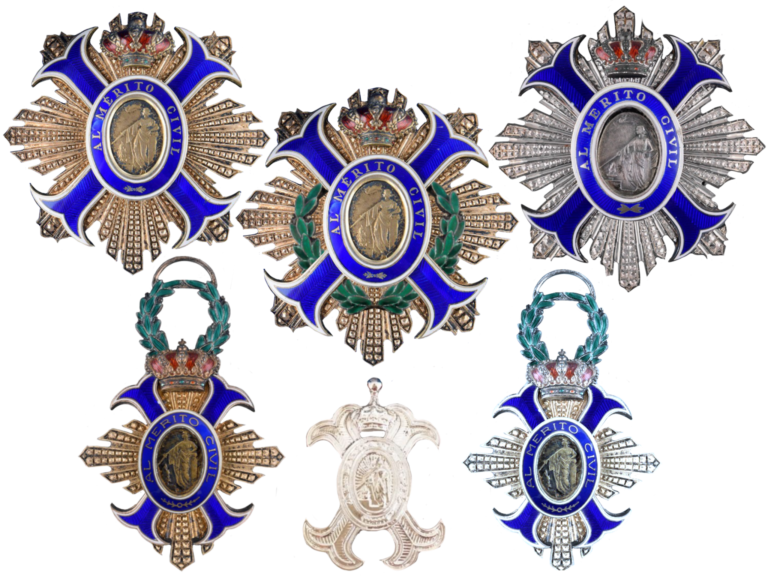
neck jewell and chest stars and silver medal of the order of civil merit
The Order of Civil Merit was instituted by King Alfonso XIII, by Royal Decree of June 25, 1926, to reward “the civic virtues of officials in the service of the State, as well as the extraordinary services of Spanish and foreign citizens in the good of the Nation”.
This decoration may also be awarded to persons of foreign nationality, provided that they have rendered distinguished services to Spain or a notable collaboration in all those matters that benefit the Nation.
His Majesty the King is the Grand Master of the Order of Civil Merit. All decorations of this Order shall be conferred in His name and the corresponding titles shall be authorized with the stamp of His signature.
The Minister of Foreign Affairs is Grand Chancellor of the Order of Civil Merit.
The Order of Civil Merit comes in seven classes as follows:
Collar (Collar) – Styled His/Her Excellency
Grand Cross -Styled His/Her Excellency
Commander by Number- Styled Illustrious Lord/Lady
Commander – Styled Lord/Lady followed by Mr. or Mrs.
Officer’s Cross- Styled Lord/Lady followed by Mr. or Mrs.
Knight’s Cross- Styled Lord/Lady followed by Mr. or Mrs.
Silver Cross- Styled Lord/Lady followed by Mr. or Mrs.
The members of the Order will have the following treatments:
The Civil Order of Alfonso X the Wise
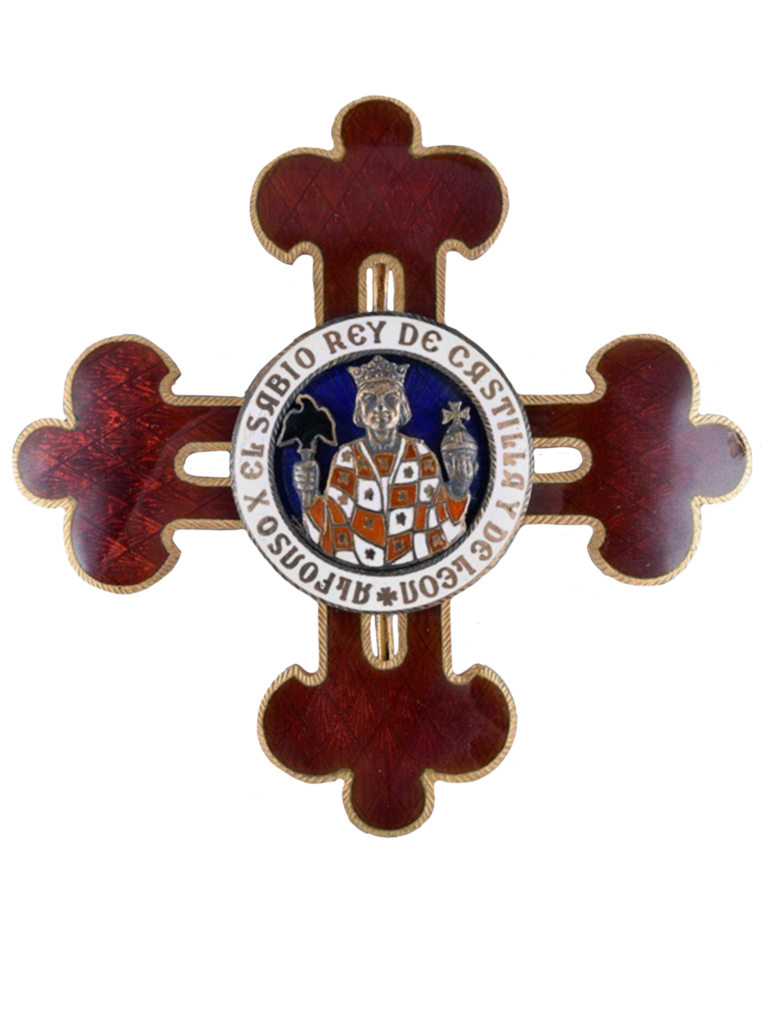
neck jewell and chest star of the civil order of alfonso X
The Civil Order of Alfonso X the Wise is intended to reward natural and legal persons and entities both Spanish and foreign, who have distinguished themselves by the merits contracted in the fields of education, science, culture, teaching and research or who have served outstanding in any of them in Spain or internationally.
The Grand Master of the Order is His Majesty the King, in whose name the various categories of the same are awarded, and to whom it is rightfully appropriate to hold the Collar.
The Grand Chancellor of the Order is the Minister of Education and Science, and the Chancellor of the Order is the Undersecretary of the Department.
The Civil order of Alfonso X, the Wise is divided into the following grades:
Collar. Awarded to heads of state or government, heads of high state institutions, and heads of international organizations. This grade is awarded by Royal Decree with the proposal of the Minister of Education, the Order’s Grand Chancellor. Holders of the collar are granted the honorific “The Most Excellent”. It is limited to six recipients.
Grand Cross. Awarded for exceptional and evident degree of achievement in education, science, culture, teaching or research. This grade is awarded by Royal Decree with the proposal of the Minister of Education. Holders of the grand cross are granted the honorific “The Most Excellent Mr. or Mrs”. It is limited to 500 recipients.
Commander with Plaque. This grade and the remaining grades are awarded based on the merits of the recipients in their field. Holders of the Commander with star are granted the honorific “The Illustrious Mr. or Mrs”. It is limited to 750 recipients.
Commander
Cross
Historical Orders
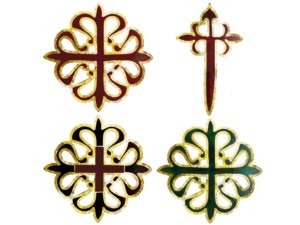
These four orders continue to exist as a “federation of Associations” with His Majesty, the King of Spain being the Grand Master as well as a Royal Council of Military Orders. This structure is based upon the same system the orders used during the Reign of the Hapsburgs. The Royal Council is made up of members from the four orders. Each member, all appointed by His Majesty, the King, are responsible for approving admission of new members and administering the activities of the orders.
The orders maintain an organizational structure which is almost identical to the one is had during the old regime.
Order de Calatrava founded by Sancho III of Toledo, King of Castile, in 1158, was the first military Order in that kingdom. The castle of Calatrava had been taken in 714 from Rodrigo, King of the Visigoths by the Moors, who held it for over four hundred years. Don Alphonso I of Aragon, recaptured it in 1147 and gave it to the Knights Templars as a bulwark against the infidels. Eight years later, the gift was returned. Sancho (son of Alphonso) gave it and the task of its defense to Don Raymond, Abbot of the Monastery of St. Mary de Fitero, in Navarre. He, with Don Diego of Velasquez, fortified the castle and settled there with associates from Castile and Toledo. Thus arose the Order of the Knights of Calatrava or Militia of Calatrava. The Order was approved by Pope Alexander III, September 25, 1164. Pope Benedict XIII assigned them a “cross flory” in 1396. The Mastership of this and of the Orders of St. James of the Sword and of Alcantara, according to Ashmole, were perpetually vested in the crown of Castile in 1523 by Pope Adrian VI. There was but one class of members—Chevaliers, who must be of noble birth. In 1219, the Ladies’ Order of Calatrava was instituted by Dona Gazelas Maria Yonnes. The badge is the same as that for the men, a white-enameled gold-edged diamond on which is a red-enameled cross fleury, i. e. with fleur-de-lis at the ends; the outer leaves are elongated, to rest upon the arms, and the points turn out. This is surmounted by a trophy of flags and a plumed helmet. The ribbon is bright red watered silk. Favine says the badge is “A Red Cross Flouredeluced”.
Order of Calatrava. The Order of St. Julian of Pereyro was founded in 1176 by Ferdinand II, King of Leon and Galicia. It derived its name from the town in which their first monastery was built. The badge was a green pear tree sewed to their mantles. After Alphonso IX, King of Leon, had captured the Castilian town of Alcantara from the Moors in 1213, he gave it to Don Martin Fernandez de Quintana, Grand Master of the Order of Calatrava. In 1218, the city of Alcantara was given by the Knights of Calatrava to Don Nunno Fernandez, the third Master of the Order of St. Julian de Pereyro and his fellow knights, who then styled themselves the Knights of Alcantara. In accepting the city they became subject to the Order of Calatrava, and changed their cross to what Favine calls “A Greene crosse Flouredeluced”. This insignia is identical with that of Calatrava, save that the color is green, as is also the suspension ribbon. This order has but one class—Chevaliers, who must be of the nobility. Pope Adrian VI (1552-1523), granted the revenues of this order as well as those of St. James and Calatrava to the crown of Castile forever.
Order of Our Lady of Montessa, or of St. George, was founded in 1316 (or, as some state, in 1317) at Montesa, a city of Valencia, by James II (1291-1327), King of Aragon and Valencia. The knights were subject to the rules of the Order of Calatrava. In 1399, the Order of St. George of Alfama, which had been founded in 1201 at Tortosa, was incorporated into this. Ashmole is the authority for the statement that in 1317 the Order of St. Mary de Merced in Aragon was amalgamated with this Order of Montesa. The badge is diamond-shaped, enameled yellow, with gold edges and with a plain, red-enameled cross in the center; the whole is surmounted by a trophy of flags and a plumed helmet. The ribbon is bright red watered silk.
Order of Santiago- Founded by King Ferdinand II in 1170, The Order of Santiago, also known as the Order of St. James of the Sword, is a religious and military order founded in the twelfth century. It owes its name to the Patron Saint of Spain, “Santiago” (St. James the Greater). Its initial objective was to protect the pilgrim of St. James’ Way, to defend Christendom and to remove the Muslim Moors from the Iberian Peninsula. Entrance was not however restricted to nobles of Spain exclusively, and so many of her members have been prominent Catholic Europeans in general. The Order of Santiago is one of the most renowned military orders in the history of the world, its insignia being particularly recognizable and abundant in Western art. The Order of Santiago is one of the four Spanish military orders, together with those of Calatrava, Alcántara, and Montesa. Today it is a civil association with the kingship of Juan Carlos I with the character of a nobiliary, honorable, and religious organization that remains as such.
This section was produced with the assistance of the Protocol Office of the Royal House of Spain.
Spain is a storied country of stone castles, snowcapped mountains, vast monuments, and sophisticated cities, all of which have made it an exciting travel destination. The country is geographically and culturally diverse. The many and varied cultures that have gone into the making of Spain—those of the Castilians, Catalonians, Lusitanians, Galicians, Basques, Romans, Arabs, Jews, and Roma, among others are renowned for their varied cuisines, customs, and prolific contributions to the world’s artistic heritage. The country has a rich and storied history, and it the premiere destination for those desiring to experience a little bit of everything. For more information about visiting Spain, visit their official travel site at: https://www.spain.info/en/about-spain/
